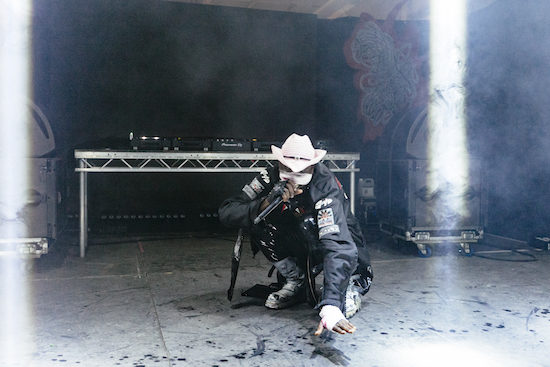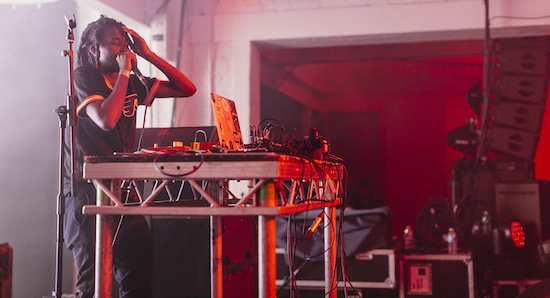Moor Mother photo by Joe Singh Snap Rock & Pop Photography
Moor Mother tackles harsh reality
A couple of minutes into Moor Mother’s set at Supersonic, the friend I’m with leans in and says, “This is what someone having a breakdown would sound like.” Faced with abrasive crackles of white noise punctuated with guttural spoken-word proclamations, it’s a reasonable observation. Much of the crowd looks like they don’t know what to do with this at first. People are standing awkwardly, as though they’re watching something they shouldn’t be.
A few hours earlier, sitting in the lounge of a hostel round the corner from the main festival site, I’d been listening to Moor Mother’s Fetish Bones on my headphones while typing up notes. The album made no sense in that context, with chatter in the background and the Nigeria-Iceland game on a big screen in the corner. Up close, her intensely personal music is more comprehensible: you enter into direct contact with the discordant frequencies of Moor Mother’s unconscious, becoming a witness to someone’s brain trying to reconcile all the contradictory forces acting upon it. Over the past few days, one of the dominant images circulating in the media was that of a tiny Central American girl, her face a mask of terror and torment as she was separated from her mother at the US border. How do you process a proto-fascistic image like that and then go about your day? These are the frayed psychological underbellies that Moor Mother explores in her work, which is confrontational and unsettling only in that it refuses to shy away from the truth.
I hear the term “android president” bubble up from within the cacophony of frazzled jazz saxophones and doom metal samples, and I get the sense of a mind at breaking point in a world where such a thing feels like a reality. Her track ‘Tell Me About It’ repeats the line “everything is not okay”, and in a way, her set deliberately bulldozes the audience’s comfort zones to remind them of this fact. But there’s a sense of catharsis that comes with someone spewing out enraged, antagonistic energies, which if left unchecked, could well facilitate a plunge into hopelessness. The momentum picks up as a juddering, distorted dancehall rhythm comes into effect, the low frequencies grounding the experience, providing a stable vehicle for dealing with the painful emotions that lyrics contain. Few artists ride so close to their own inner turbulence, and while Supersonic as a whole is a full of acts who disrupt expectations, Moor Mother stayed with me the longest.
Goat and Joasihno disassemble sounds
While Moor Mother (and to a certain extent, Yves Tumor, who during a menacing set on Saturday cusses the audience for their poor mosh pit skills and yells “Where’s the anger at? Where’s the aggression?”) probes the question of the role of music in channeling disruptive, difficult emotions and confronting harsh social realities, other artists at Supersonic are more concerned with destabilising the music-making process itself.
On the opening night, this approach was demonstrated in the most militant fashion by Goat. During their first tune each member of the quartet began tapping a different rhythm on a separate drum, building into a piece of tight, complex and almost clinical polyrhythms. Even as they pick up their instruments, everything is funnelled into rhythm, while melody remains a distant wisp in the distance. Sax player Akihiko Ando mutes his instrument with a plastic bottle, sending one-note screeches to interlace with the the drums and bass, which is also played with all muted strings. All of this strips away any expectations of how and why instruments should be used.
A counterpoint to this austere, minimalist approach comes the following afternoon, during a display of DIY electronics by German duo Joasihno. Rather than play on a stage, they play on the middle of the floor, surrounded by mounds of midi keyboards, controllers, xylophones and various percussion instruments stuck to the floor haphazardly with gaffer tape. Their playful compositions, fully of fuzzy beats and dreamy synth lines, seem to emerge out of improvisation and a beautifully messy, curious approach to the mechanics of building sounds. They use xylophone beaters stuck to long bits of wood, which are in turn attached to a rotor, to hit cymbals and cow bells scattered over the floor – all components of what they term a ‘robot orchestra’. The scene reminds me of being taken to the Science Museum as a kid in the early 90s and left to run amok in the play area, building tiny structures, seeing how things fit together, letting objects fall and splatter in impromptu experiments. It’s music making born out of getting down on the floor and trying things out, seeing how the physicality of hitting an object to emit a sound can be harnessed, angled and directed in a multitude of ways.
Mario Batkovic digs deep
While many of the artists who played over the weekend challenged the process of making music, others instead chose to explore the potential of one particular instrument. Of these, Bosnian-born Mario Batkovic is a highlight, playing a captivating set that pushes at all the boundaries of his accordion in terms of genre, performance and technical skill.
He seems intent on coaxing only the most idiosyncratic notes from his instrument, from gorgeous, deep and rich drones to lithe, complex arpeggio patterns. Not only have I never heard the accordion played in this way before, but I’ve never realised the physical tenacity it takes to play one. His technical prowess, sonically adventurous approach and profound connection to his instrument is accompanied by an impish sense of humour – he pulls faces, goads the audience, and cracks jokes about how horrible it is to drink a bottle of water while sat alone on a stage being watched by hundreds of people. While much of what I saw over the weekend is boundary-pushing or iconoclastic in some way, Batkovic is one of the few performers who opt to instead to take his listeners on an exploratory mission, and we leave the auditorium satisfied with what we discovered.

Yves Tumor photo by Joe Singh Snap Rock & Pop Photography
Traditional English folk songs need preserving
National pride doesn’t have to be a bad thing – surely it’s important that we celebrate the many wonderful, strange, beautiful people that reside in England (while not forgetting to celebrate the people that happen not to). The music of Shirley Collins perfectly illustrates this. After a 38 year hiatus, Shirley’s return to music feels potent. Lodestar, her 2015 release, much like her previous recordings celebrates the people of England whom have been oppressed by the country itself. It’s quite clear that even Shirley herself fears traditional English folk songs, originally passed around by travellers and working class are slowly eroding from the public ear.
It’s easy to feel uneasy simply about being English, especially at a festival that was intermittently surrounded this year by screenings of World Cup games and football fans whose national pride dallies close to toxic nationalism. Collins’ work and particularly her performance on Sunday for me eases that unease. It feels important that we protect our history, particularly of those least privileged. Shirley herself seemed quite overwhelmed at the reception her performance got. Blushing when members of the audience screamed her name.
Englishness can be ghastly
In truth Collins’ is one of few figures in music that manages to find a lateral way to explore English-ness. Gazelle Twin, who headlined the previous night dissected a contrasting ghastly side of Englishness. The costume Elizabeth Bernholz wears for Pastoral isn’t actually that surreal in the current climate. Her getup had a striking resemblance to a man who was selling England flags outside one of those World Cup screenings. Like Shirley Collins’ show, the Gazelle Twin set featured Morris dancing and a part-medieval aesthetic. But Gazelle Twin’s vision of England is a lot more terrifying.
Arrogance can be amazing
For the most part, during his set, Yves Tumor seems to just flick some buttons and function as a sort of hype man. But rather than encouraging the audience, he belittles them. That could lead you to believe that his show was a bit shit, when in fact it was quite the opposite. He’s mesmerising, he oozes this twisted sexuality that I couldn’t define as masculine, feminine or anywhere in between. The arrogance just makes it even sexier.
Yunohana Variations are incongruous and incredible
Yunohana Variations is three artists from disparate musical backgrounds. Susie Ibarra studied with Earl Buster Smith of Sun Ra’s Arkestra; Yoshimio drums with Boredoms; Robert Aiki Aubrey Lowe performs under the guise of Lichens, primarily exploring the human voice and modular synthesis, and he’s contributed to the wonderful scores of Sicora and Arrival. Yunohana Variations is a great example of formless improv that is not just engaging but enthralling, perhaps even transcendent. The trio performed just before Shirley Collins, which rather summarises Supersonic’s greatness as a festival.
Every day is history
Modern Ritual is a collaboration put together by Laura Cannell, who performs gorgeous eerie violin and recorder pieces towards the end of the show. The series of performances are an exploration into nature, sound, emotion, identity and how these notions entangle in our daily lives. Jennifer Lucy Allan gives a history of foghorns, accompanied by the ominous sound of one; our own Luke Turner reads about the corners of the forest and its connections to human sexuality; Hoofus creates starting oscillations that explore manmade territories being reclaimed by the natural world; Cannell plays from her soon-released new album. It all finishes with Charles Hayward of This Heat playing a 30-minute drum roll. (Tonight, rather brilliantly, it was cut to 15 minutes for logistical reasons.) The fusing of wildly divergent ideas about modern ritual makes the whole gig more exciting and more satisfying – each segment different from and connected to the last.



